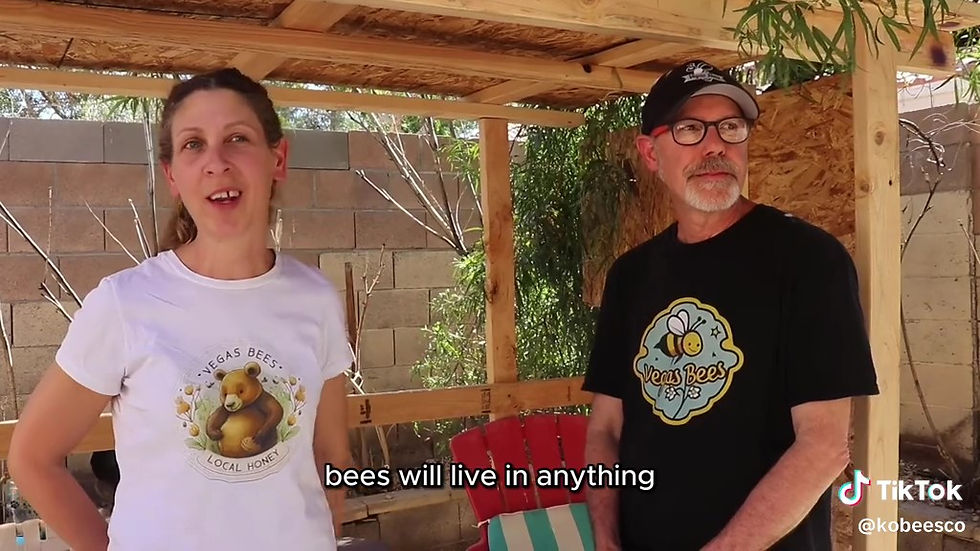
The Hidden Magic of Bees: How They Bring Your Halloween to Life
Halloween is a time for costumes, candy, and, of course, the iconic jack-o-lanterns lighting up the night. But have you ever paused to wonder how that perfect, round, orange pumpkin came to be?
Well, it's time to tip our witch's hats to the unsung heroes of Halloween: the bees.
The Magic of Pollination: How Bees Help Grow Your Halloween Pumpkins
Pumpkin plants work a little like wizards. They have separate male and female flowers, and while the male flowers produce the magical ingredient (pollen), they need some help to get it to the female flowers.
Enter the bees, who act as tiny pollination couriers, carrying pollen from flower to flower and helping pumpkins grow. Without these bees, your favorite jack-o-lantern might never see the light of a spooky October evening.
Bees are the Winged Wizards of the Pumpkin Patch
As bees visit flowers to collect nectar and pollen for their hives, they unintentionally pollinate pumpkin plants. Their fuzzy bodies become dusted with pollen as they travel between the male and female flowers, allowing pumpkins to grow.
This is no small feat—a single bee can pollinate up to 1,000 pumpkin flowers in one day! When you're carving a pumpkin this Halloween, remember that it was bees who helped bring it to life.

Honeybees and Bumblebees: Pumpkin Pollination Pros
Among bees, honeybees and bumblebees are the most adept at pollinating pumpkins. Their hairy bodies act like natural paintbrushes, gathering and spreading pollen with ease. As they go about their business, they're also collecting nectar to bring back to their hives. Talk about multi-tasking!
In fact, while they're helping your pumpkins grow, they're also making honey and feeding their young.
Why Bees Matter Beyond Halloween
While bees are crucial to our Halloween traditions, they’re also essential to the health of our entire food system. Bees pollinate more than 75% of the crops we eat, including apples, almonds, and squash.
Sadly, bees are facing growing threats from habitat loss, pesticides, and climate change. Without them, not only would our pumpkin patches be in jeopardy, but our entire food supply could be at risk.
A Call to Action: Protect Our Halloween Heroes
This Halloween, as you carve your jack-o-lanterns or bake a pumpkin pie, take a moment to toast the bees who made it possible. But don’t stop there!
You can help protect these incredible pollinators by planting bee-friendly flowers like asters, goldenrod, and sunflowers in your garden. These plants provide the nectar and pollen bees need to survive, and in return, they’ll help your garden—and pumpkins—thrive.

Bee-Friendly Gardening Tips for Halloween
Want to create a haven for bees in your yard? Here are a few tips:
Plant bee-friendly flowers: Asters, goldenrods, and sunflowers are excellent choices for the fall season. These flowers provide bees with crucial late-season nectar.
Avoid pesticides: Many chemicals used in gardening can harm bees. Opt for natural pest control methods instead.
Provide water: Bees get thirsty too! A shallow dish of water with a few stones for them to perch on can make a world of difference.
Frequently Asked Questions About Bees and Halloween
How do bees contribute to Halloween celebrations?
Bees pollinate the pumpkin plants that grow the pumpkins we carve into jack-o-lanterns.
What is the process of bee pollination for pumpkins?
Bees transfer pollen from male to female pumpkin flowers, which enables the growth of pumpkins.
Why are honeybees and bumblebees important for pumpkin growth?
Honeybees and bumblebees are particularly effective at pollinating pumpkin flowers because their hairy bodies easily pick up and deposit pollen.

How can I make my garden bee-friendly for Halloween?
Plant bee-friendly flowers and avoid using harmful pesticides.
How many pumpkin flowers can a single bee pollinate in a day?
A single bee can pollinate up to 1,000 pumpkin flowers in a single day.
How do bees benefit from pollinating pumpkin flowers?
Bees collect nectar and pollen, which they use to feed their colonies.
Happy Haunting and Bee-utiful Pumpkin Crafting!
As you enjoy this Halloween, remember the incredible bees who helped bring your pumpkins to life. Let’s do our part to protect these hardworking pollinators and keep the magic of Halloween—and nature—alive for years to come.
Betsy and Pete
Vegas Bees
Las Vegas, Nevada
About Us: The Authors

We're Betsy and Pete, passionate Las Vegas beekeepers trained by a master in the field. With hundreds of successful bee and bee swarm removals under our belts, we're not just experts; we're enthusiasts committed to the well-being of these incredible pollinators.
We manage dozens of beehives, both natural and honey-bearing at our Joshua Tree Preserve.
Our Commitment to Excellence
Education is an ongoing journey, especially in a dynamic field such as beekeeping. That's why we continually update our knowledge base, collaborate with other experts, and stay up to date with the latest advancements in bee control methods and beekeeping practices.
We also provide top-tier beekeeping supplies, offering everything a beekeeper needs, from beginners to experts.
.png)